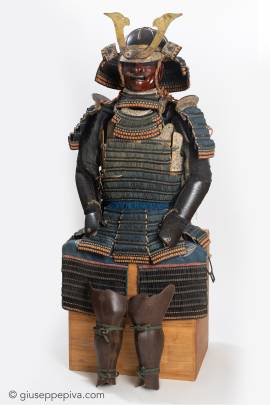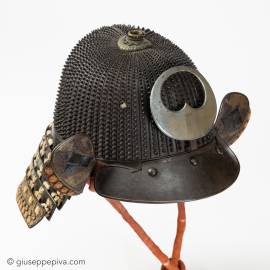Azuchi-Momoyama period (1575 - 1615)16th century, refurbished in 1796 Provenance:Takekoshi Dochin (died 1556)Matsuoka OshikasukeInscribed under one sode: 寛政癸戌春被属修理 / 竹腰道鎮公古甲 松岡牡鹿輔 + kaoAccording to a label stitched inside one of the sode, the armor was repaired in 1796. The inscription is signed by Matsuoka Oshikasuke, a scholar of the Tokugawa clan, retainer in Nagoya, student of Motoori Norinaga.Takekoshi Dochin, whose name is written by Oshikasuke in his inscription, was a general commander of the Sengoku period, lord of the Ogaki castle in Mino. He died in 1556 during the battle of...
WORKS FOR SALE
Nagaeboshi Kawari KabutoSamurai Helmet designed as a court capMid Edo period Edo (1615 - 1867), 18th centuryThis spectacular helmet is meant to reproduce the cap worn by shinto priests. Of unusual shape, it is built of five iron riveted plates, covered with a textured gold lacquer and embossed with a red “ken” on the back. On the front, a rare triple maedate is supported by three different tsunomoto (supports).The shikoro is a rare kusari-shikoro made in three sections of chain mail under a wide black-lacquered plate molded as a lotus...
Early Edo Period, 17th Century A 62-plate koboshi-bachi [helmet bowl with small standing rivets] of typical tenkokuzan form, with 30 pointed rivets on each plate decreasing in size towards the top, with the exception of the larger front plate, with three lines of rivets and the small one on the back which is left blank, for a total of 1,890 rivets.Even if unsigned, the tenkokuzan shape of the bowl (bachi), lower in the center and slightly higher on the back and some other features such as the number and arrangement of rivets, suggest an attribution to...
Copyright © 2016 - giuseppe piva - VAT: 05104180962










